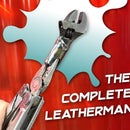Introduction: Repair Box
I love repairing stuff, it gives me great satisfaction to put something broken back in business. No fix is too small or big (ok sometimes I give up, but will reuse the parts:-) As my love for box making is expanding I came to the conclusion that a box for all my tools when repairing was missing. Not only that, I really miss a space to do most of my repairs. This has resulted in a two-part solution. I hope this Instructables inspire you to do more repairs, being an Instructabler you are most probably already a fixer!
Supplies
My starting point was a sheet of poplar plywood, 122cm by 82cm.
- 40cm hinge
- 2cm hinge x 2
- Locking hinge
- Locking mechanism x 3 (3 different solutions)
Optional
- Green felt
- Gooseneck as a flashlight stand
- 3D printed accessories
- Multiple repair utilities (depends on what your favorite repairs are)
Tools
- Traditional woodworking tools
- Ask the community if you want to try some of the more expensive ones
Step 1: Measure Twice…
How big should a repair box be? It needs to fit a typewriter! Why? Well, I just bought a beauty, the Olivetti Lettera 32, late 60's early 70's produced in Barcelona. Let's hope this is the right size, so far it feels perfect, large enough but also small enough to store. I wanted it to look so good it can be stored out in the open:-)
Knowing the dimensions I made the planning of how to cut everything super important to sketch up. I even did a drawing in Illustrator to get exact measures.
Sizes:
Large box: 40x50x14cm
Small box: 40x10x14cm
Total: 40x60x14
Step 2: Glue Up!
No need for a Nobel Prize in mathematics for this part. I find this part a bit like Lego building and love that as a first step the volume becomes visible. I use wood glue and I love the nailgun, but hammer and nail are just fine too.
Go to the source, my favorite Adam Savage has a great video on the art of box making:
Step 3: What's in the Box
Left to dry overnight and eager to start the next process. It's router time!!! I love round corners, a little sanding helps the finish. Now, let's split the bugger. I wanted the two boxes to have a different opening, more fun and surprising that way. Can stop opening and closing it:-) A table saw helps for the lids, but as I wanted to have an angle I needed to use my jigsaw, and with a little patience the line is straight outta Compton. A few more sanding passes and hinges are ready to be screwed on. To make sure the fit would work I left some pieces of felt in the lid frame. Always remember that the saw blade shaves off a few millimeters!!!
Step 4: Hang On
Ok, so this is the sweet spot, I wanted the Repair Box to have a detachable box for the smaller fixes, sewing, broken reading glasses, etc. I've had this locking mechanism (bed rail brackets) laying around for a while and now they came to use, finally. Well having a router made this part very pleasant, and having a router bit the exact same size as the lock… sweeeet!!! Made sure to measure not 2, 3, or 4 but 5 times:-) After doing the one side I put the metal on its head a pressed the two parts together so I would make a mark on the wood so I knew it was aligned. And by enormous luck… a near-perfect fit🤩
Step 5: Felt Carpet, Sort Of…
Often when doing a repair I want to have some sort of fabric to minimize the accidents. For this build, I found some leftover green felt I felt 😂 was perfect. The size was not a go but an application of contact glue fixed that. What was a bonus was cutting the smaller box, because what was leftover from cutting the lid frame snuggly fit in the bottom inside of the box.
Step 6: Let Coffee Dry
Soooooooo satisfying… Nothing wrong with plywood, but it looks like plywood! For all my boxes I have one routine in common, they all get the secret coffee treatment… Damn, they look good coming out of the conveyor belt!!!
Step 7: Can You Handle It?
I ended up placing the handle on the box when the two parts were attached. That's mostly the situation when carrying the Repair Box, so made sense for the middle position when combined. The router helped in getting the shapes for the leather handle to fit nicely and with no extra wiggle room. The handle has a lock and click on solution. The weight so far has been no problem.
Step 8: Bottom Up
To make sure never to open the box upside down I went for a black bottom. Also to save any surface I would use to fix things I used leftover felt and glued them on so it would be stable together and a part.
Step 9: Make It Shine
For the next step, it's really important, to sand down the outside. The wood grain in plywood rises and needs a brushing. The Coffee mixture makes the box 90% beautiful, the remaining 100% comes when giving these babies two/three passes of clear spray lacquer. Boooom it pops! I leave the inside un-treated, which gives more contrast to the outer finish.
Step 10: Light, Action, Fix…
I've found that a well-light environment is a must when repairing, but sometimes you need that spot to be bang on target. I wanted to have a flashlight attached to a gooseneck so I could position in any angle I wanted and that I also could pull the flashlight off and make closer inspections.
The gooseneck ball attachment is 17mm in diameter.
Step 11: Shut It!
To keep everything in check I've added 3 locks. One large for the large lid and one small to keep it tight in all corners. The little box needs only one lock.
Putting Some Make Up On
There is no secret I love stamps, and for every new build, I tend to have new stamps made. I think the detail they add is "the prick over the i" as we say in Norway (google it:-) Other pieces of found type and metal badges get their placement. Make sure you buy ink that is smudge-proof, seriously I know why!
Step 12: The Travelling Repair Man
This journey has begun a long time ago, but only now can I get up and do emergencies repairs outside of the house. And inside, if I don't finish I can close the lid and continue the next day. I'm still figuring out what repair tools to include, I'm open to suggestions:-) Just made a 3D printed tool holder, but have not given it the stress test yet.
Please get in touch and I'll come and visit, or even better keep adding to your own repair skills and inspire others. I'd love to see your take on this build.
Repairing the world one fix at a time!
If you enjoyed this Instructable please follow along over at my Instagram: @smogdog for more builds… & boxes
Step 13: Two Repairs, a 1000 to Go…
Since building the box I have already made 3 repairs, the typewriter, an old lamp needing rewiring, and an old record player. Try and stop me now, I'm on a roll!!!








